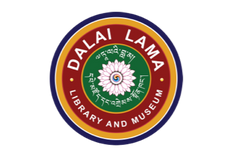
Photo Courtesy of Mark Seliger
About His Holiness
the 14th Dalai Lama
His Holiness the 14th Dalai Lama, Tenzin Gyatso, describes himself as a simple Buddhist monk. He is the spiritual leader of Tibet. He was born on 6 July 1935, to a farming family, in a small hamlet located in Taktser, Amdo, northeastern Tibet. At the age of two, the child, then named Lhamo Dhondup, was recognized as the reincarnation of the previous 13th Dalai Lama, Thubten Gyatso.
Not only has the Dalai Lama served as a spiritual teacher to hundreds of thousands of Tibetan Buddhists, he has also guided the Tibetan people as a political leader through the tumultuous times of the communist invasion and occupation of Tibet, and through their journey into life in exile. Due to the Chinese communist invasion of Tibet, the Dalai Lama was forced to escape from Lhasa in 1959 and relocated to Dharamsala, India, along with Namgyal Monastery.
His Holiness Dalai Lama Has A Dream
"I have confidence that through education, through
awareness. I think we can develop a sense of the oneness of humanity."
- His Holiness the 14th Dalai Lama

The Dalai Lama's Blessing
To serve the needs of all people through education and empowerment, the Namgyal Monastery Institute of Buddhist Studies in Ithaca, NY and Namgyal Monastery in Dharamsala, India agreed on a plan to build a library and a museum, dedicated to the powerful teachings of non-sectarian Buddhism. This step towards realizing the great visions of His Holiness the Dalai Lama, as well as a gesture of repaying a tiny portion of his compassion was enough for the Abbot and the Executive Council of Namgyal Monastery to receive this plan with genuine appreciation, dedication, and happiness.
His Holiness the Dalai Lama gave his consent on April 28, 2016 to create The Library, Learning Center and Museum of the 14th Dalai Lama.

Commitments of His Holiness the Dalai Lama
Promote Basic Human Values
Compassion, forgiveness, tolerance, contentment and self-discipline
regardless of nationality, religion or origin
Promote World
Peace
Cultivate compassionate communities and impact social change
Protect the
Environment
Encourage discussions about climate change and global warming to raise awareness of our collective responsibility
Bridge Science & Contemplative Wisdom
Foster intergenerational and multidisciplinary dialogue from diverse perspectives and experiences to leverage insights that inspire action for positive change
Promote Religious
Harmony
Seek understanding through inter-religious dialogue to create good human beings as all religions carry the same message of love
Preserve Tibetan
Culture
Protect its people, language, literature, art forms,architecture, performing arts and environment as Tibetan culture is a culture of compassion, nonviolence, and peace
